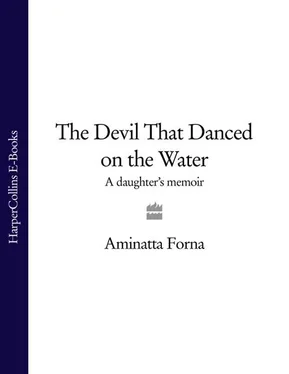Not one of my elderly aunts, who recounted the story of Ya Beyas to me, could tell me how or why he should do so. But they were clear: he had forgotten. He had not been waylaid or confused, found her family had disappeared or never returned to Mamunta. He forgot. Perhaps, I thought to myself as I listened, he drank too much omole.
Again Ya Beyas begged him to take a message and the trader promised that this time it would get there. In the meantime she resigned herself to twelve more months in Matoko.
The trader was true to his word. Some months later two of Ya Beyas’s brothers, Pa Santigi Kamara and Pa Yambas Sana, arrived in Mamunta, splendidly attired in gold-embroidered robes as befitted their status, followed by retainers carrying everything required to formally redeem their stolen sister: a barrel of palm oil, a sack of rice, a cow, a sack of pure salt, a tie of tobacco leaves, one woven country cloth and four silver shillings. These gifts they presented in the barrie before the paramount chief, the elders and Pa Morlai. When the ceremony was over Ya Beyas was a free woman.
Ya Beyas wanted nothing more than to go back to Mamunta to see her family, but Pa Morlai was loath to allow her to leave. She might no longer be a slave, but as his wife she had to obey her husband. A sore on her foot had turned septic, and Pa Morlai insisted that she stay under the care of his healer until she could walk properly.
The seasons had run through twice more by the time Ya Beyas wore her husband down. He seemed to find an unlimited number of new reasons why she should stay in Bombali and he obliged her to do his bidding. At last he relented and agreed to the journey. Ya Beyas wanted her daughter Hawa to accompany her, but Pa Morlai imposed his will one last time and refused to allow it, for the young woman was betrothed to a youth in Matoko. He suggested she travel with their second son Saidu instead.
Pa Morlai waited in his house in Matoko for Ya Beyas to return, but the rains came and went and there was no sign of her. Unlike his wife, who had learned patience, Pa Morlai was not born with a great deal and his small store soon ran out. One morning he rose, walked to the door of his house, snapped his fingers to summon his retainers and ordered them to begin preparations for a journey. Within a short time he and his entourage were ready and they set out, back across the Katabai Hills to Temneland, carrying with them a large calabash.
In Mamunta Pa Morlai stood before Pa Santigi’s house, knocked and waited. After a few moments he knocked again. The third time the door was answered and he entered.
In front of him walked a delicate girl, his youngest niece, who carried the tremendous calabash on her head. Under the weight of it her neck swayed like a pawpaw tree overburdened by fruit. The room within was full of people. Trembling, the girl laid the calabash at the feet of Pa Santigi, who sat cross-legged on a low stool. He looked inside and helped himself to a few of the cola nuts before passing the rest around the assembled company. After a few moments he looked expectantly at Pa Morlai, the conqueror now turned supplicant, who cleared his throat and announced his business.
‘I have seen a flower,’ he said, using the customary words of a prospective bridegroom in the house of his beloved. ‘And that flower is growing here, in the house of the Kamaras.’
Pa Santigi gave a signal and three girls were brought forth. The first one advanced and stood before Pa Morlai. Her face was covered by a cloth and he carefully raised it. No – he shook his head. Each woman was presented and each time, even though they were fresh and lovely, he looked at the woman he had been offered, declined and waited.
The three young women left through the door and stood outside, where their muffled giggles could be heard in the stately silence of the room. A fourth figure appeared at the door: rings of age thickened her waist and her neck; as she moved she dragged her foot slightly. Pa Morlai had no need to raise the cloth that covered her face. He nodded. ‘Here is my flower.’
In front of her gathered family – elders, brothers, uncles, aunts, cousins, nephews and nieces – Ya Beyas paused; then she bent and picked up the calabash. With that gesture she accepted Pa Morlai as her husband, not as a slave, but as a free woman. She sat on the floor next to her elder brother with the calabash containing her dowry on her lap.
Inside Ya Beyas’s wedding calabash were cola nuts, a symbol of friendship; bitter cola nuts to represent hardship; a prayer mat; a head of tobacco for the elders who would counsel the couple through the highs and lows of married life; atara alligator pepper which, if the seeds were kept in the pod, would for ever bring peace to a union; and a needle and thread, to remind the bride of her wifely duty. And finally, at the bottom of the pot, in gold, silver and precious stones was the measure of her worth as a woman.
A few days after the ceremony Pa Morlai prepared to leave Mamunta for Matoko. He went to Ya Beyas and told her he planned to leave. He assumed she would accompany him, but he was careful to couch his command as a request. ‘So, Beyas, it’s time for you to say goodbye to your family. We should leave for Matoko in a few days.’
Ya Beyas looked at her husband. Pa Morlai was nearly seventy, an old man, and she was already middle-aged. She let her eyes linger on his face, his eyes, his mouth. He was her captor, her owner, her husband and the father of her children. She looked down and replied slowly, barely audibly: ‘No, my husband. I will not.’ This was Ya Beyas’s sole act of defiance in her entire life: a life lived as a daughter, sister, slave and junior wife.
And so Pa Morlai returned alone to Matoko, where he died some years later. Ya Beyas stayed in Mamunta, with her son Saidu. And no one knows, to this day, whether Pa Morlai and Ya Beyas ever laid eyes on each other again after their wedding day.
Once Pa Roke noticed me. I was following a line of ants across the ground to the entrance into their nest, a hole by the roots of the mango tree. Above me the trunk of the tree seethed with ants. I was placing obstacles in the path of the column to see whether the ants would break formation. When Pa Roke’s shadow fell across me, I had just laid a long stick on the ground in front of them.
I fancied I knew how the ants communicated with each other. When the giant obstacle suddenly appeared across their path, a couple of ants raced each way some distance down the length of the stick. They were the scouts. The others, the bearers, waited patiently with their loads. The scout ants came back and reported that there was no way of going round the object, it would take too long. They would have to climb over. The other ants waved their antennae in agreement, or so I imagined. And without delay an advance party set out up and over the stick.
The lives of ants could hold me spellbound for hours. There were the regular black ones that everyone knew. Then there were the tiny red ones – they were the ones that gave you stinging bites. If you stood near their nest they swarmed up your leg and sank thousands of tiny teeth into you, leaving painful red marks. Several times the size of the ordinary ants were the giant ones, which could be either red or black. They were harmless, but discouragingly large. Overall the black ants were by far and away the friendlier of the species.
There were ant hills all over the surrounding country. Acre upon acre turned to moonscape by the giant moguls, often interspersed with termite hills that towered over the ant hills like giant stalagmite fortresses. War raged constantly between the armies of the termites, the red ants and the black ants. They killed, captured and enslaved each other.
Читать дальше












